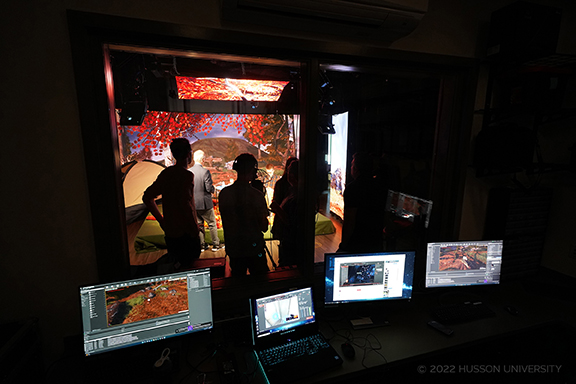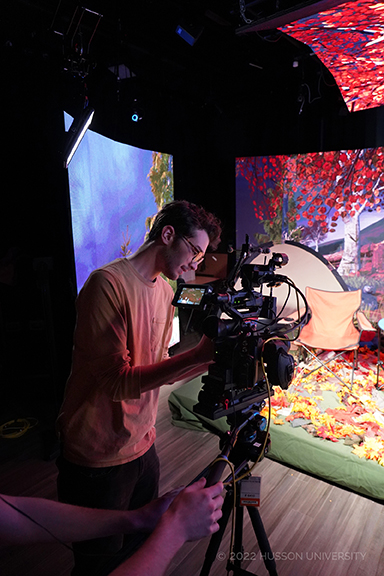
XR: What It Is and How Star Wars Is Involved
Published on: November 30, 2022

You've probably seen The Mandalorian, the popular Star Wars spin-off series that follows a masked, intergalactic bounty hunter and his young charge, Baby Yoda (er... Grogu). It's an exciting show, filled with spectacular effects and amazing visuals. But you may not know that some of those visuals are created using state-of-the-art extended reality, or XR, techniques. You also may not know that the technique they use perfectly exemplifies the unique mix of old-school creativity and cutting-edge technology that makes XR one of the most unique and exciting technological developments in recent memory.
But what does that mean? And what's it got to do with Husson University's School of Technology and Innovation? We'll explain. But first, let's dig into exactly what this technology is.
What is XR?
Before we can dig into exactly what extended reality (XR) is, we first need to define augmented reality (AR) and virtual reality (VR).
- In an AR experience, you can see and interact with both the real world and virtual images, sounds, and haptic touch. AR is fairly common these days: many apps on your mobile phone use sensors to superimpose interactive digital objects over real-world objects. (Ever used a Snapchat or TikTok filter to change your image on your phone? If so, you've experienced AR.) AR glasses are another frequent application of this technology, as are immersive AR environments that require no additional devices.
- In VR, you are immersed in a fully realized three-dimensional environment, filled with sight, sound, and even touch sensations. Though VR was long the realm of science fiction, it's become very accessible to all people via products such as VR goggles like the Oculus Rift.
Extended reality, XR, is an umbrella term for three-dimensional, interactive computing environments created via AR and VR. Noted American computer scientist Ronald Azuma has defined three requirements for AR, but they neatly apply to XR as well. These requirements are: 1), it must be registered in a 3D space, immersing the user in an environment of sight, sound, and haptics; 2) it must be interactive in real-time, allowing users to interact with digital objects at the speed of real life; 3) it must combine the real and virtual. XR is built around the idea of a digital twin – a virtual model that reflects a physical object or person – that is integrated with your real world in a meaningful way.
How XR Is Used
While XR, in its many forms, is still a relatively new technology whose applications are still being discovered, it already is making an impact. Education, retail, healthcare, marketing, entertainment: in just about any industry or field you can think of, XR is being used to change and improve the experience of customers and employees alike.
 Consider a furniture retailer such as IKEA. IKEA can have its customers download an app that uses XR technology. Then, the customer can select a piece of furniture, and use that XR app to see how exactly that furniture will look in their living room. Maybe the customer will see that a particular couch is too big for their space, or maybe they'll see that it's a perfect fit. Either way, the customer is able to make a more informed decision thanks to XR technology.
Consider a furniture retailer such as IKEA. IKEA can have its customers download an app that uses XR technology. Then, the customer can select a piece of furniture, and use that XR app to see how exactly that furniture will look in their living room. Maybe the customer will see that a particular couch is too big for their space, or maybe they'll see that it's a perfect fit. Either way, the customer is able to make a more informed decision thanks to XR technology.
For another example, consider manufacturing. Many factories depend on specialized equipment that can be difficult to fix and maintain. In the past, if one of those pieces broke, the factory would lose productivity and have to bring in an expert to make expensive repairs (or spend a fortune on a completely new machine). With XR, though, a technician could put on a pair of XR glasses such as the HoloLens and see detailed instructions and diagrams detailing how they can fix the machinery in real-time.
The potential uses are countless. Retailers like Walmart can use XR to train their employees on best practices for stocking or even how to react in active shooter situations. Educators can immerse their students in different environments, letting them see the subjects of their studies up close rather than just reading about them in books. Architects and builders can use XR to visualize and share how new structures will look in public spaces and identify potential issues before construction has even begun. And these examples are just the tip of the iceberg: it's no wonder that some researchers have projected that XR technology could boost the global gross domestic product (GDP) by up to $1.5 trillion by the year 2030.
That brings us back to The Mandalorian. Unlike many big, special effects-driven productions (such as the Star Wars prequel trilogy) that utilize green screen technology, The Mandalorian uses an XR technology called an LED video wall referred to as "the volume." It's made up of a huge number of LED screen modules on a curved wall that goes 20 feet high. These monitors display pre-filmed or pre-rendered backdrops that the actors can shoot in front of.
Essentially, it's the same idea as a painted backdrop used in classic movies or even onstage but enhanced by 21st-century technology to create a 3D, immersive environment for the show to be filmed in. And unlike green screen soundstages in which actors have to imagine the digital environments that are added later, the LED wall allows more realistic lighting, greater flexibility, and an immersive shooting experience for the actors and crew. The filmmakers know exactly how their shot will look as it's being filmed, while the actors can see the environment they're interacting with, yielding performances that are more realistic, spontaneous, and relatable to the audience.
Expect to see more movies and TV shows filmed using this technology. In fact, it's so adaptable and cost-efficient that even independent rock bands can utilize it to quickly film music videos with a scope that previously wouldn't have been imaginable. In short, by utilizing XR with creativity and skill, you can make almost any idea a reality.
Be Part of the XR Future with a Degree from Husson
Indeed, one of the most exciting aspects of XR is that it isn't just a technical field. While understanding computers, coding, and technology is a must, successful XR also requires an ample amount of creative vision.
That's why Husson University's Bachelor of Science in Extended Reality (XR) program in the School of Technology and Innovation has a comprehensive curriculum that covers XR topics such as motion capture, 3D scanning integrated with 3D modeling, game engines, and software development for virtual and augmented reality, as well as graphic design, photography, audio engineering, and video production. Housed in our state-of-the-art iEX Center, the XR program will prepare you to take the lead in this rapidly growing field and give you the opportunity to get hands-on with this amazing technology.
If you're ready to make an impact on our world or on a galaxy far away, XR can give you the means to do it. We invite you to request more info or apply today and begin working towards making your dreams an (extended) reality.
Back to All Articles